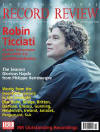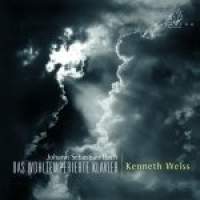Texte paru dans: / Appeared in:
*

International Record Review - (10//2014)
Pour
s'abonner / Subscription information
Satirino
SR141

Code-barres / Barcode : 3760061191419
Over the course of the past year I have heard complete cycles of the 48 performed on harpsichord, clavichord, organ and piano. This has led me to three specific thoughts. First, that nobody in his or her right mind should really sit down and listen to all 48 in one go; second, that to listen to all of them on the same instrument is a bad idea; and third, that these constitute some of the most wonderful and sublime music ever written for keyboard. Taking the third as a completely convincing argument for committing them to disc, and the first as a warning to the listener rather than a plea to performers, that leaves the second for me to ponder at length.
Contemporary thinking on the performing of Das wohltemperierte Clavier inclines to the view that, if all 48 were actually intended for performance rather than just as compositional exercises, then this could just as easily have been on any of the instruments mentioned above (by the time he had written the second book, Bach had encountered early versions of the piano), and certainly there is nothing at all to suggest that he at any time envisaged the whole lot being performed on the same instrument. Clearly certain pairings of prelude and fugue work best on different instruments and the most rewarding listening experience would seem to be to cherry‑pick individual works from recordings on different instruments. Thus, from Book 1, the C major with its strong connections to the last part of Bach's Pièce d'Orgue, BWV572, seems to work best on the organ despite the relish with which some pianists thickly encrust its upward arpeggios with the sustaining pedal, while the gently throbbing B flat minor, the obvious inspiration behind Szymanowski's Op. 4 Etude in the same key, seems to work best on the piano, where subtle nuances of touch and dynamic can better convey the inner textural detail. Remaining with Book 1, surely the dazzling toccata‑like figurations of the G major Prelude along with its jaunty Fugue seem to encapsulate the essence of the harpsichord, and does not the intimacy of the G minor reveal itself best in the private world of the clavichord? But it is given to only the most committed collector to have available excellent recordings on an appropriate range of instruments so, unless and until some enterprising record company embarks on the contentious process of choosing different instruments for each prelude and fugue, we have to live with a recording of all 48 on a single instrument.
Here we have one on the harpsichord, and on the surface of it a pretty authentic choice of instrument too. Originally made by Andreas Ruckers in Antwerp in 1646, rebuilt by Pascal Taskin in 1780 and further restored and amended at the end of the nineteenth century by Louis Tomasini, in 1972 by Hubert Bédart and, most recently, by Von Nagel in 1990, it is currently in the possession of the Musée de la musique in Paris. The single illustration on the back of the booklet shows it to be a truly lovely looking instrument, and one only wishes a little more space would have been given to highlighting its visual charms, perhaps with some closer image of the detail within the lid. The odd thing is, it sounds so smooth and polished that one might be forgiven for thinking that this is actually a clever electronic harpsichord‑style sound‑making machine.
Bereft of the clatter and action noise which led one famous musician at around the time of the harpsichord's revival in 1960s England to talk of it making a sound like tiptoeing over broken glass, only by donning a pair of top‑quality headphones and ratcheting up the volume to near maximum can one detect the merest hint of returning jacks at the end of each musical phrase. Is this the result of a painstakingly filtered recording and editing process or simply Kenneth Weiss's close and undemonstrative fingerwork? Certainly Weiss holds his musical cards very close to his chest, creating an impression of inwardly contemplating the music rather than opening it up and displaying it for public consumption. His approach is reflected in his introductory note, in which he talks of being 'humbled before this unique collection' and using 'a prelude and fugue a day ... to hold life's tensions away'. And if that sounds all a little fanciful, try this: 'Each finger must be an agile acrobat, a bel canto singer, a team player: the mind must keep constant watch that the ears and heart are open.' Thankfully his playing is generally a lot less cliché‑ridden, if not always fully able to escape an underlying sense of reverence. Interestingly, too, that abutting Weiss's spiritual utterances, Richard Langham Smith's slightly less pithy booklet note pours scorn on the notion of approaching this music 'with reverence and wonder'.
This combination of an almost disembodied harpsichord sound and Weiss's internalized readings yields some intriguing effects. Something akin to a piano emerges from Weiss's richly sustained playing for the C sharp minor Prelude from Book 2 and his crisply enunciated staccato touch in the Fugue, and his way of playing the Prelude of the E flat major (also from Book 2) has an almost clavichordal quality. Most of all, the long held notes of the D sharp minor Book 2 Fugue resound like organ pipes. In short, here is a true chameleon of a player, transcending the limitations of his chosen instrument to illuminate Bach's music, as it were, from within.
Weiss's
playing is mercifully free from idiosyncrasies or demonstrative gestures,
and while he very occasionally enjoys some rhythmic waywardness (I find the
C sharp minor from Book I a little too stiffly moving for comfort), he
largely succeeds in maintaining a positive metrical flow without resorting
to hypnotically mechanical momentum. Underlying everything here is great
depth of musicianship, which is so sincere and compelling that it
effectively dismisses my first two thoughts, and powerfully underlines the
third.
Fermer la fenêtre/Close window
Cliquez l'un ou l'autre
bouton pour découvrir bien d'autres critiques de CD
Click either button for many other reviews


